With so many newsletter platforms available, it’s important to pick one that matches your needs, whether it’s design flexibility, audience analytics, automation tools, or monetization options. In this guide, we’ll explore the best newsletter platforms to help you launch, grow, and manage your newsletter successfully in 2025.
1. Beehiiv
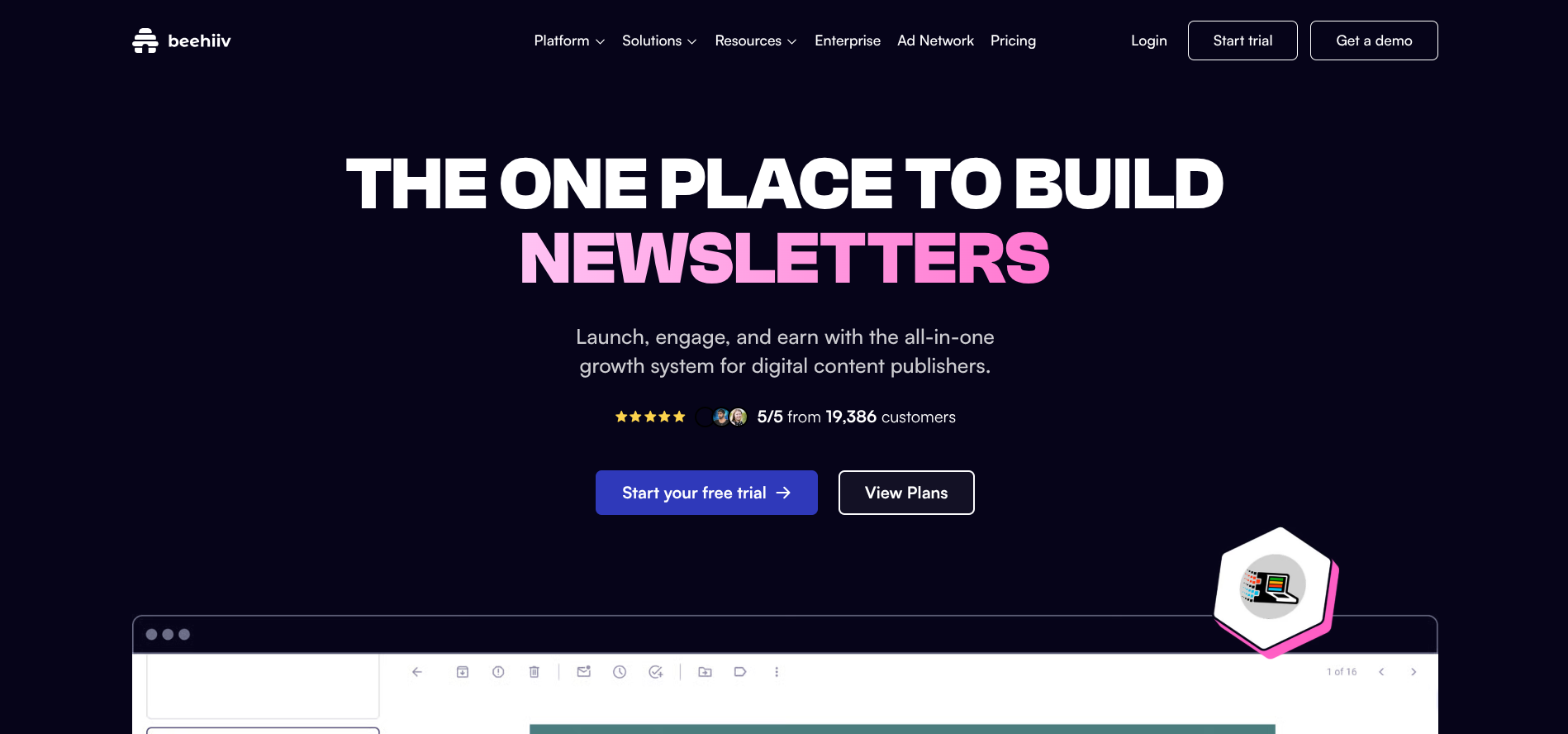
Beehiiv is an all-in-one newsletter platform built for creators who are serious about growth. Founded by early members of the Morning Brew (one of the most successful business newsletters in the world)
Beehiiv is designed with growth, monetization, and simplicity in mind.
What Makes Beehiiv Unique?
Beehiiv’s biggest strength lies in its focus on growth and monetization. While most newsletter tools stop at writing and sending emails, Beehiiv goes further by giving you built-in features like:
Referral Program – Encourage your readers to invite friends and grow your audience organically.
Boosts Marketplace – Promote other newsletters (or get promoted) for passive income.
Native Ad Network – Get matched with relevant advertisers and earn from your content.
Paid Subscriptions – Offer multiple payment models including “Pay What You Want” and lifetime plans.
And the best part - Beehiiv doesn’t take a cut of your earnings.
Ease of Use and Design
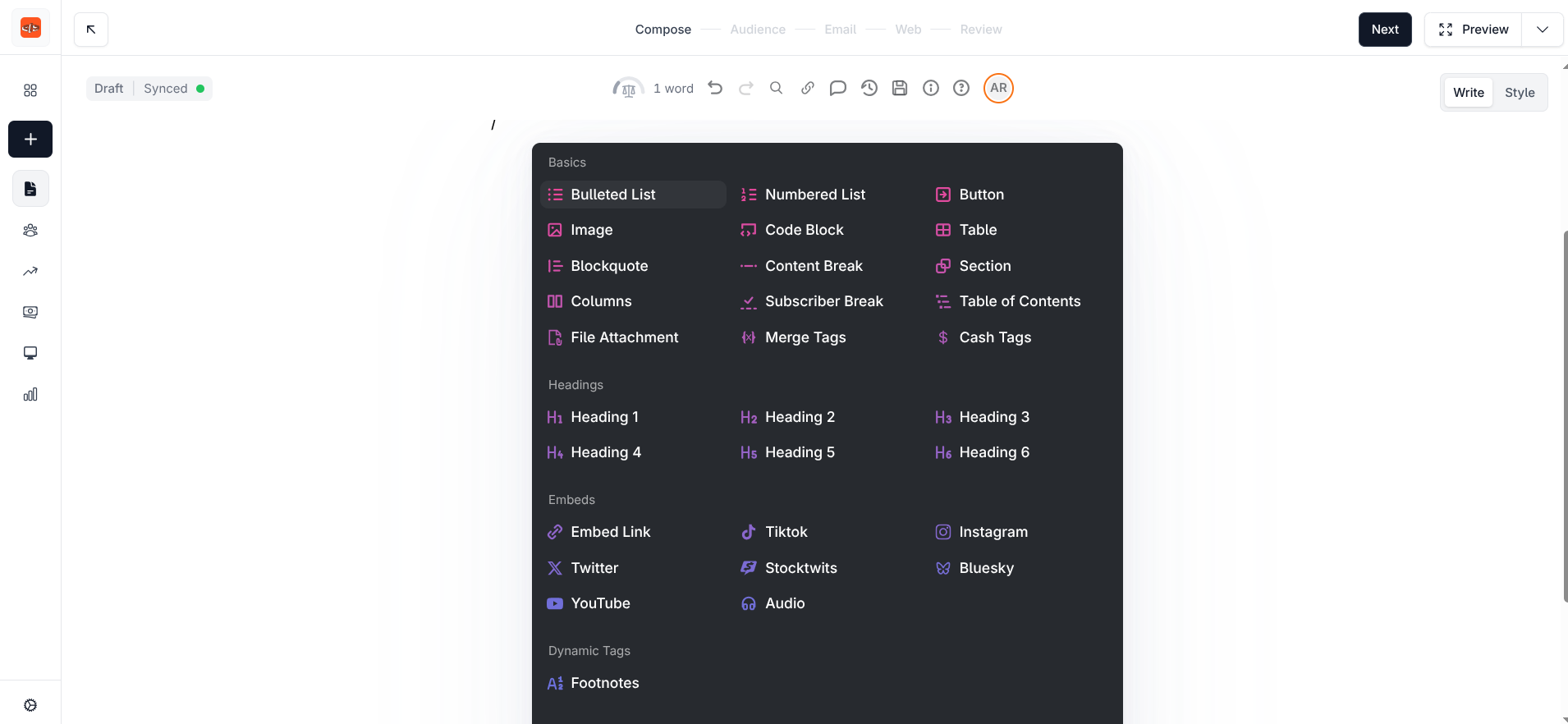
Beehiiv’s minimal, distraction-free editor makes it easy to craft emails that look great on any device. It’s designed to be intuitive, even for beginners.
Each newsletter you send also doubles as a webpage, making your past issues SEO-friendly and discoverable online. Recently, Beehiiv has also introduced a website builder with pre-made templates and a mobile app builder, allowing creators to turn their newsletter into a standalone branded app.
However, Beehiiv’s design customization is limited, it doesn’t come with pre-built email templates yet, so you’ll need to build your own layouts (which you can reuse later).
Monetization and Growth Tools
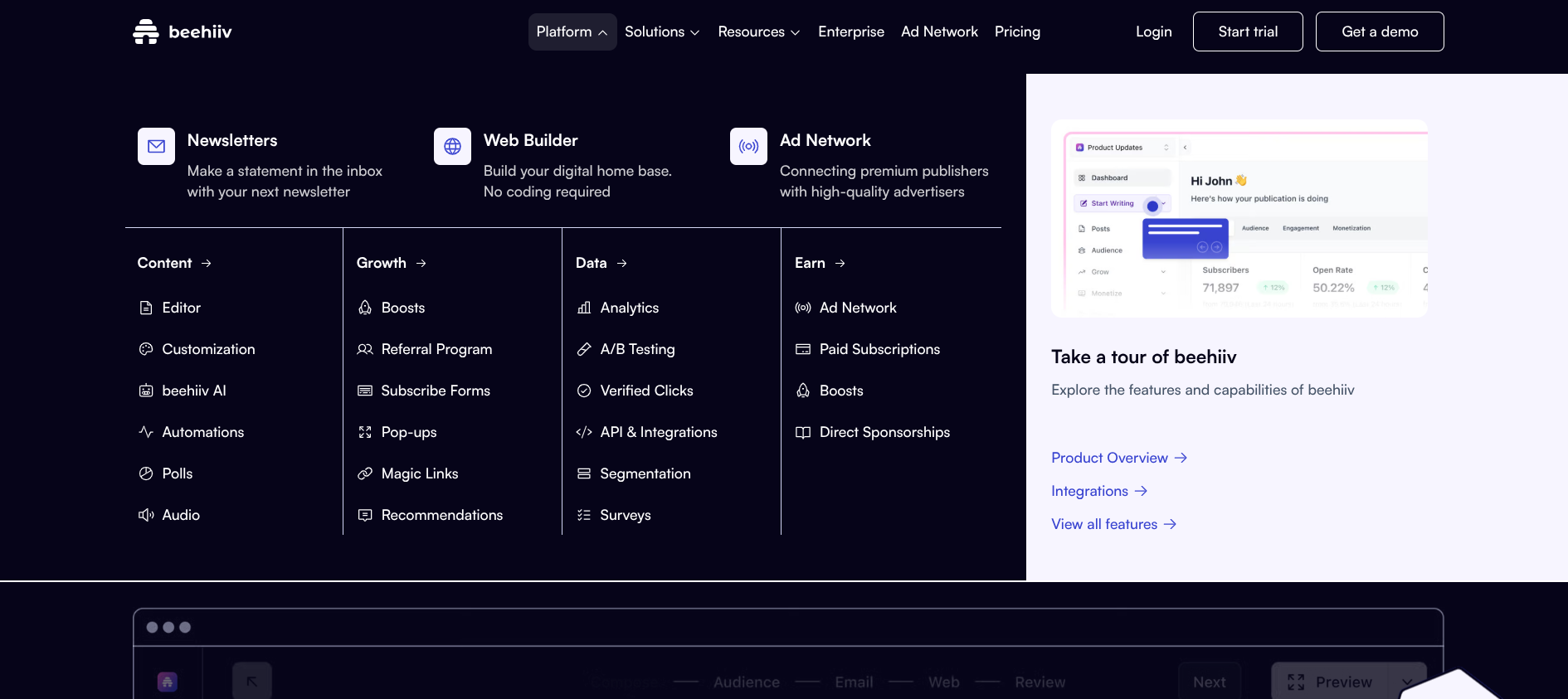
Beehiiv is one of the few platforms built from the ground up for monetizing newsletters. Here’s how:
Paid Subscriptions: Offer multiple pricing models beyond monthly/yearly - including lifetime or “Pay What You Want” plans.
Boosts: Get paid for recommending other newsletters or pay to have yours featured in theirs.
Ad Network: Join Beehiiv’s ad marketplace to automatically receive ad offers that fit your audience.
Referral Program: Reward readers who bring new subscribers to your list.
These tools are integrated directly into Beehiiv, you don’t need external apps or plugins to start earning.
Analytics and Performance Tracking
Beehiiv provides detailed analytics dashboards that help you track open rates, click-throughs, subscriber sources, and audience growth over time.
You can also integrate Beehiiv with Zapier, unlocking connections to thousands of third-party apps and automations (like CRMs, social media tools, or analytics platforms).
Pricing
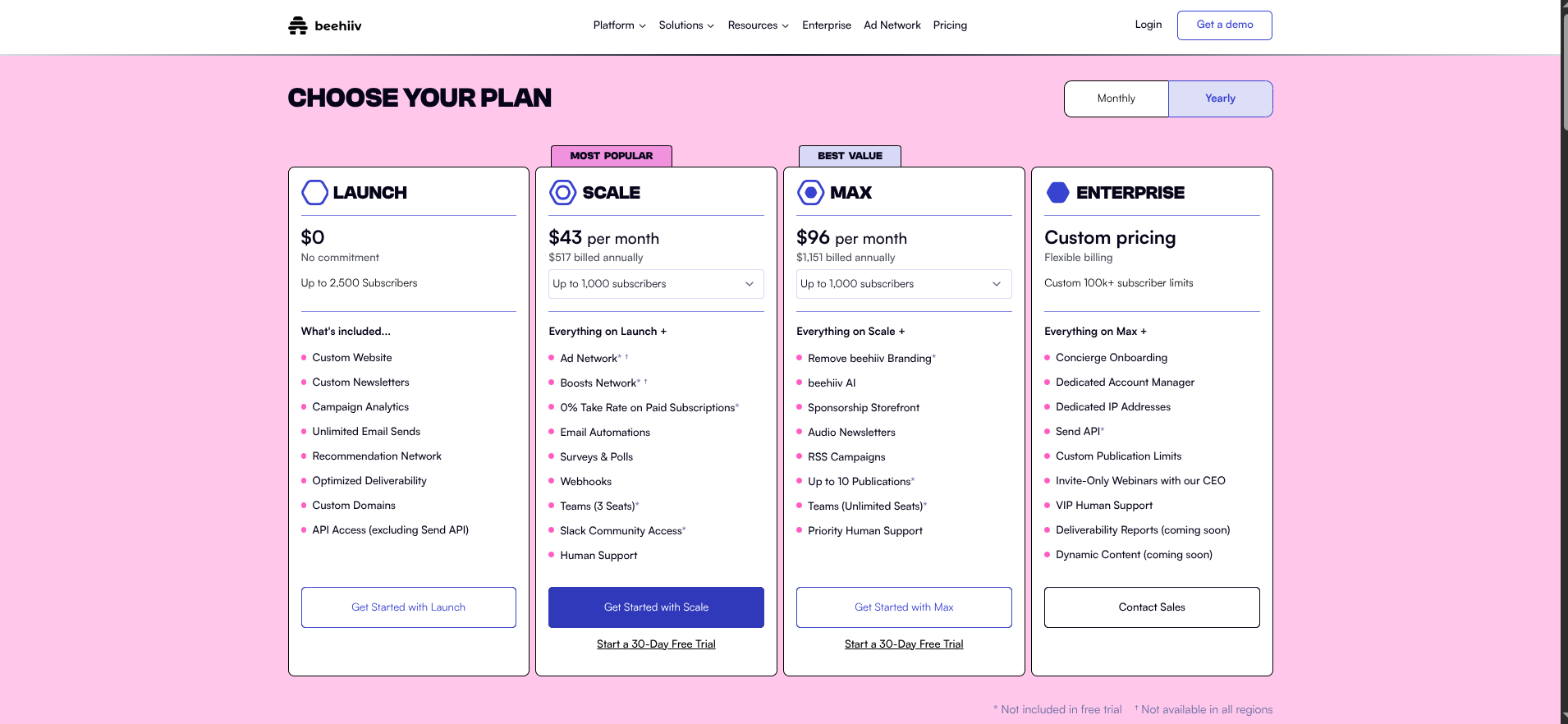 Beehiiv offers one of the most generous free plans in the industry:
Beehiiv offers one of the most generous free plans in the industry:
| Plan | Price | Subscribers | Key Features |
|---|---|---|---|
| Launch | $0/month | Up to 2,500 | Unlimited emails, core features |
| Scale | $49/month | Starts at 1,000 | Custom domain, premium subscriptions, ad network, polls |
| Max | $109/month | Starts at 1,000 | Removes branding, includes course + priority support |
| Enterprise | Custom | Unlimited | Dedicated account manager, IP, and onboarding |
Even on the free plan, you can send unlimited emails and manage up to 2,500 subscribers which is rare for a free-tier tool.
And Beehiiv doesn’t charge any platform fees on your revenue, making it highly creator-friendly.
Pros and Cons
Pros
- Built-in growth and monetization tools Generous free plan (2,500 subscribers, unlimited emails)
- Advanced analytics and SEO-friendly web pages
- No revenue share, you keep 100% of your earnings
- Frequent updates and feature rollouts
Cons
- Limited email design options
- Paid monetization tools locked behind premium plans
- Higher starting price ($49/month for 1,000 subs)
- Who Should Use Beehiiv?
Who Is Beehiiv For?
Beehiiv is ideal for writers, podcasters, journalists, and creators who want more than just a newsletter, they want a growth and revenue engine.
If you’re just starting out, the free plan is generous enough to build momentum. And if you’re ready to grow or monetize, Beehiiv’s paid plans unlock powerful features with no platform fees.
2. ConvertKit (Kit)
ConvertKit, now simply known as Kit - is an all-in-one newsletter and email marketing platform built for creators who mean business.
Originally launched as a simple text-based email tool, it has evolved into a powerful platform that combines automation, audience segmentation, monetization, and digital product sales - all in one place.
If you’re a digital creator, online educator, or solopreneur looking to sell products, offer paid subscriptions, and automate your marketing, Kit might be exactly what you need.
What Makes ConvertKit (Kit) Unique?
Kit stands out for its deep creator-focused ecosystem. Unlike traditional email marketing tools, it’s designed not just to send newsletters but to help you grow, nurture, and monetize your audience.
Some of its standout features include:
Advanced Automation: Build sophisticated email sequences that trigger based on user actions and tags.
Digital Product Sales: Sell courses, eBooks, templates, or any digital product directly from within your emails.
Paid Subscriptions: Offer multiple pricing tiers and collect payments seamlessly.
Tip Jar: Let fans contribute any amount they wish to support your work.
Creator Network: Collaborate with other creators through paid recommendations and cross-promotions.
Kit even includes a native Sponsor Network to help you find advertisers for your newsletter - turning your content into a genuine revenue stream.
Ease of Use and Design
Kit is creator-friendly and intuitive, especially once you understand how its automation and tagging system works.
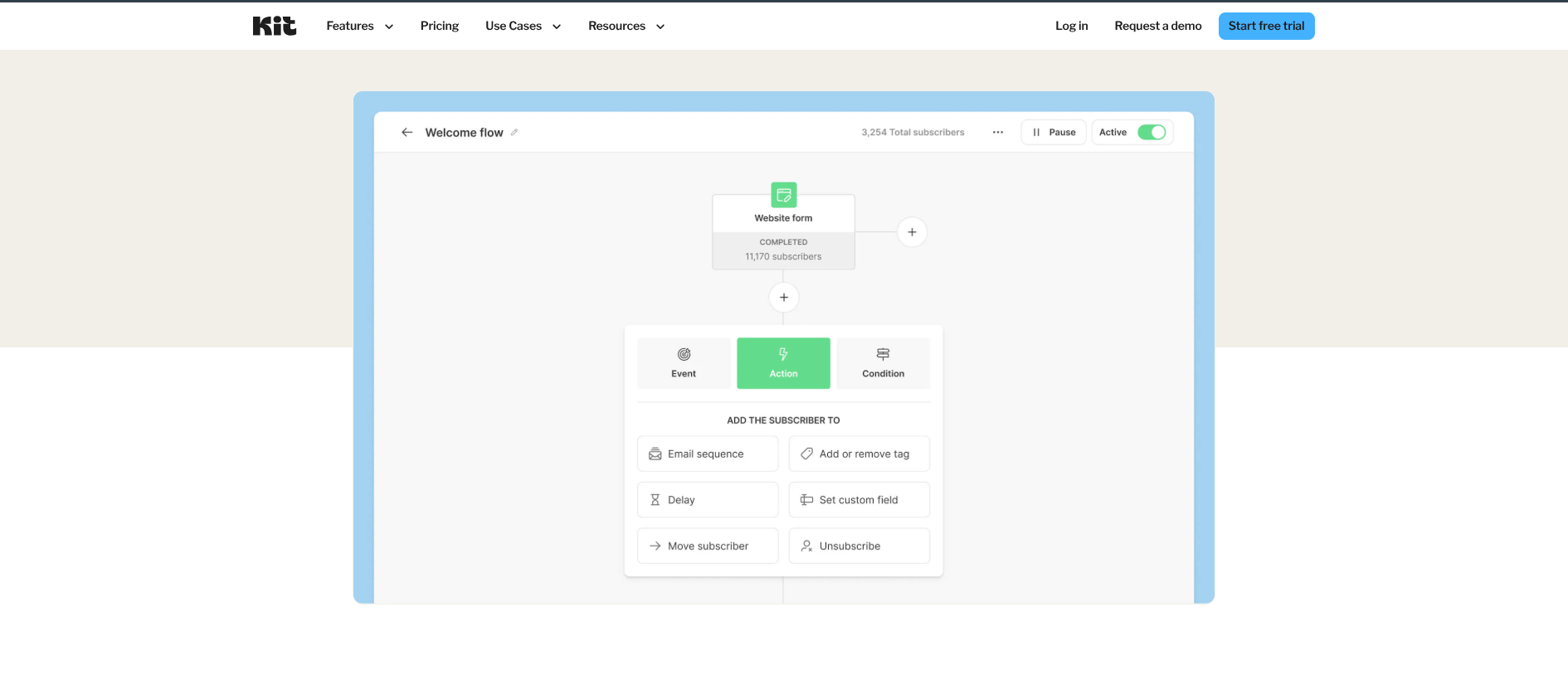
Its visual automation builder is one of the best in the industry, allowing you to set up complex workflows with simple drag-and-drop logic. You can trigger sequences based on subscriber behavior, interests, or purchases, making personalization easy.
It also includes a landing page and form builder, so you can collect leads without needing another website tool.
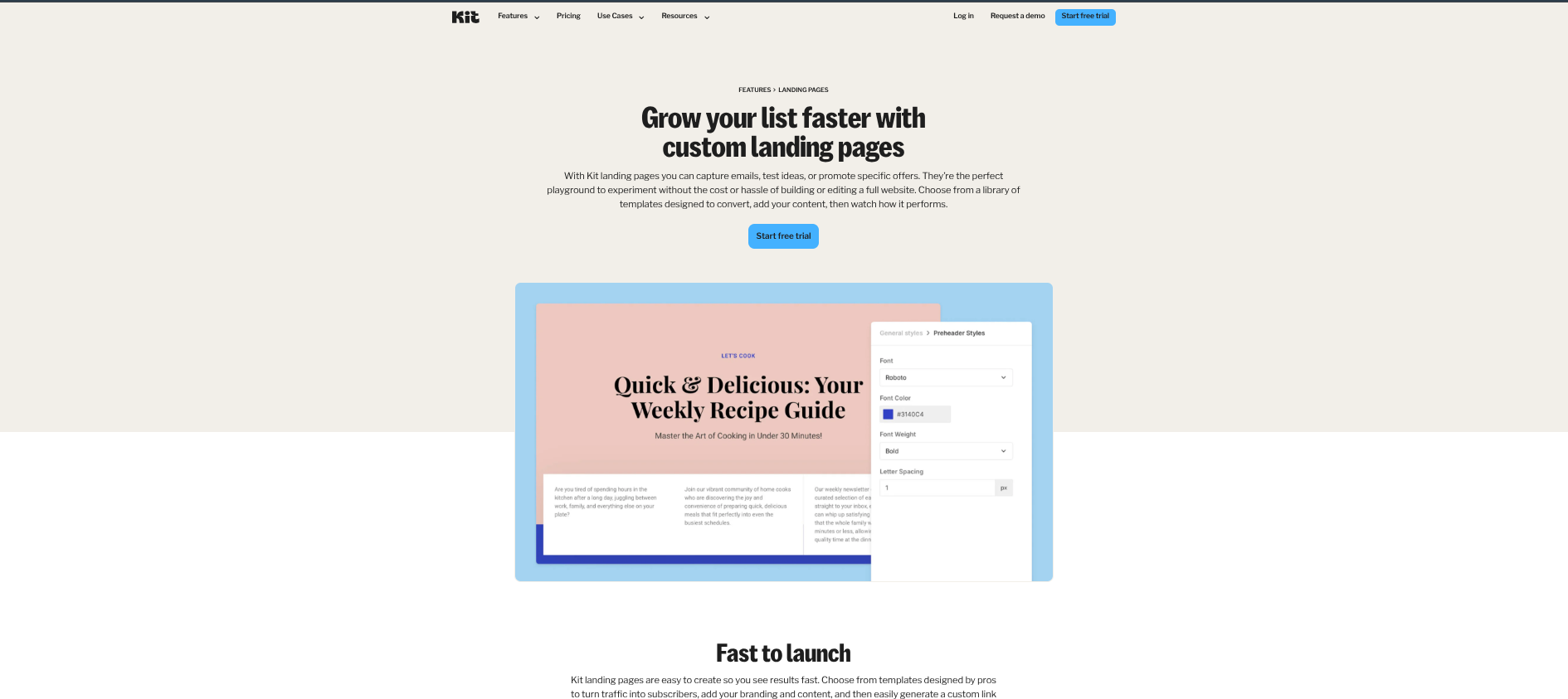
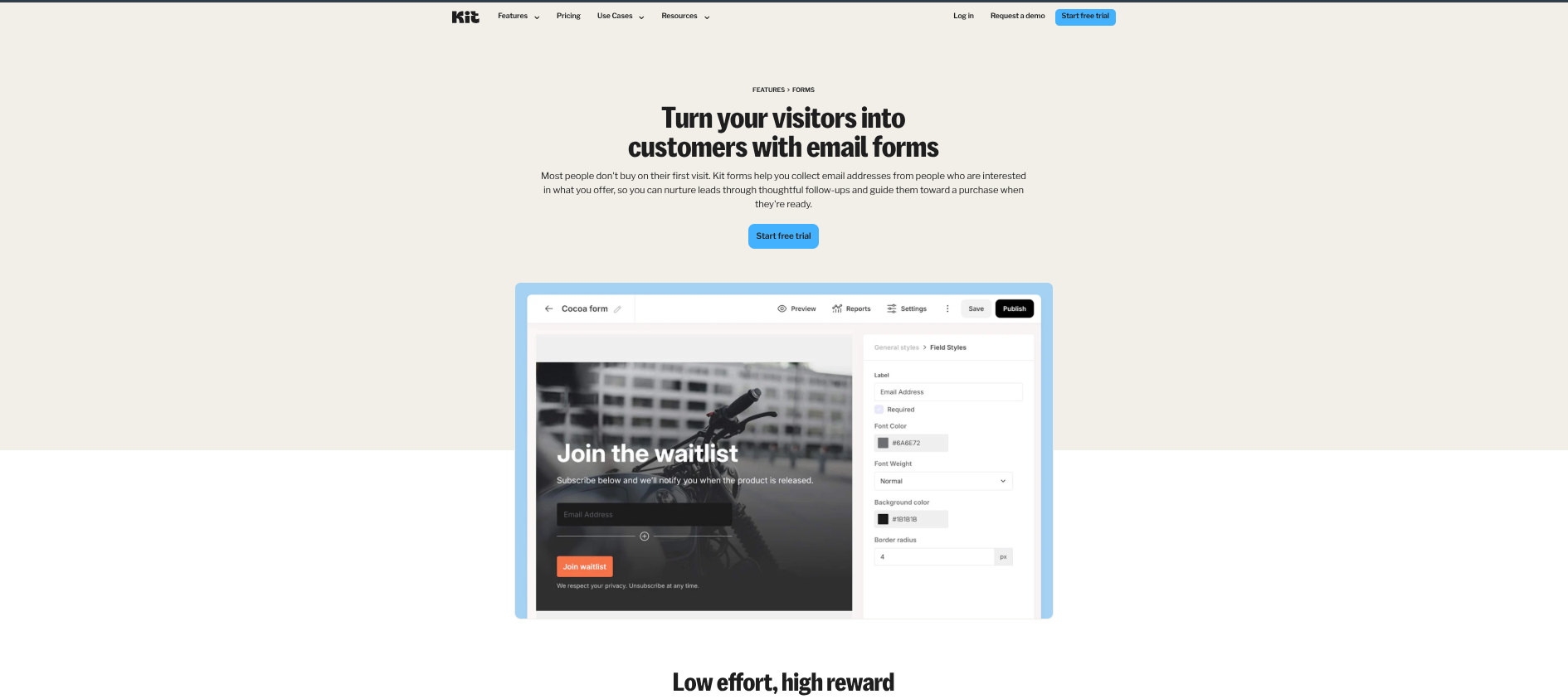
However, when it comes to email design, Kit keeps things minimal focusing on clean, text-first layouts rather than flashy templates. This works well for personal brands and creators who prioritize storytelling over design-heavy campaigns.
Monetization and Growth Tools
It’s one of the few platforms that lets you manage multiple income streams from the same dashboard:
- Sell Digital Products: Host and sell eBooks, courses, or templates directly through Kit, no need for external checkout tools.
- Offer Paid Subscriptions: Create premium newsletter tiers and charge readers for exclusive content.
- Tip Jar: Collect direct financial support from fans at any time.
- Sponsor Network: Find ad opportunities that match your audience.
- Creator Network: Get recommended by other creators or recommend theirs to grow your list collaboratively.
Even on the free plan, you can start charging for your newsletter (with a small transaction fee of 3.5% + $0.30 per payment). That’s a far better deal than Substack’s 10% cut.
Automation and Segmentation
ConvertKit’s automation tools are a major reason why creators love it. You can:
- Send targeted campaigns based on subscriber behavior.
- Build drip sequences and complex email funnels visually.
- Use tagging to organize your audience by interests, actions, or purchases.
- These advanced automations make Kit a powerful marketing engine for growing and converting your audience over time.
Pricing
Kit offers both a generous free plan and flexible paid tiers.
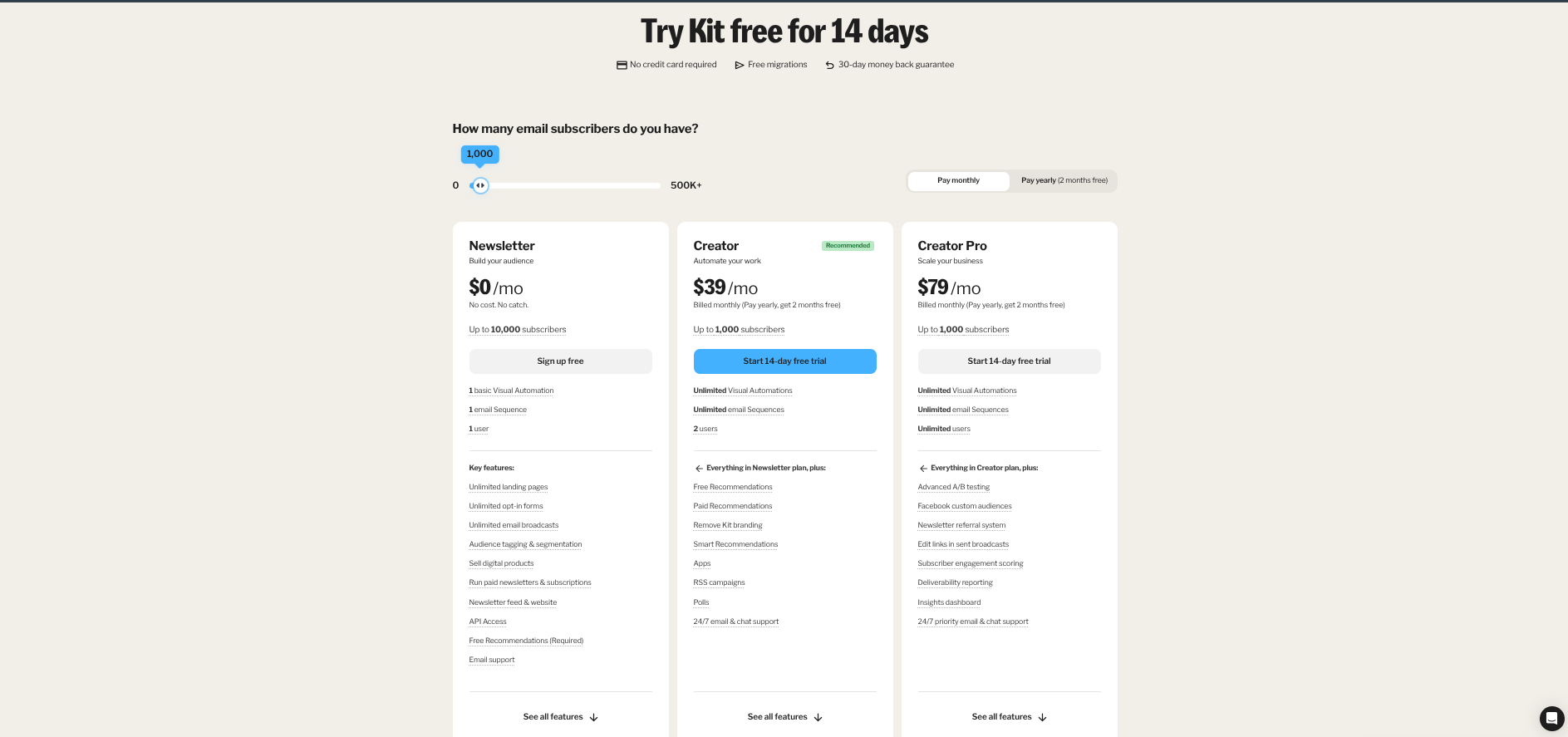
| Plan | Price | Subscribers | Key Features |
|---|---|---|---|
| Free | $0/month | Up to 10,000 | Unlimited emails, paid subscriptions, 3.5% + $0.30 transaction fee |
| Creator | $39/month | 1,000 | Advanced automation, audience tagging, premium support |
| Creator Pro | $79/month | 1,000 | Priority support, referral system, advanced analytics |
While pricing rises as your list grows, Kit’s built-in monetization tools can easily offset the cost once you start earning from subscribers or product sales.
Pros and Cons
Pros
- Generous free plan (up to 10,000 subscribers and paid newsletters)
- Integrated product sales and Tip Jar
- Advanced automation and tagging
- Creator Network and Sponsor Network
- Excellent deliverability and audience management
Cons
- Prices increase quickly as your audience grows
- Slight learning curve for beginners
- Limited email design flexibility
Who Is Kit For?
Kit is best suited for creators, educators, writers, and digital entrepreneurs who want to grow and monetize their audience from a single platform.
Whether you’re selling an online course, running a paid newsletter, or simply growing your list, Kit offers a clean, reliable, and powerful toolset tailored for serious creators.
3. Mailchimp
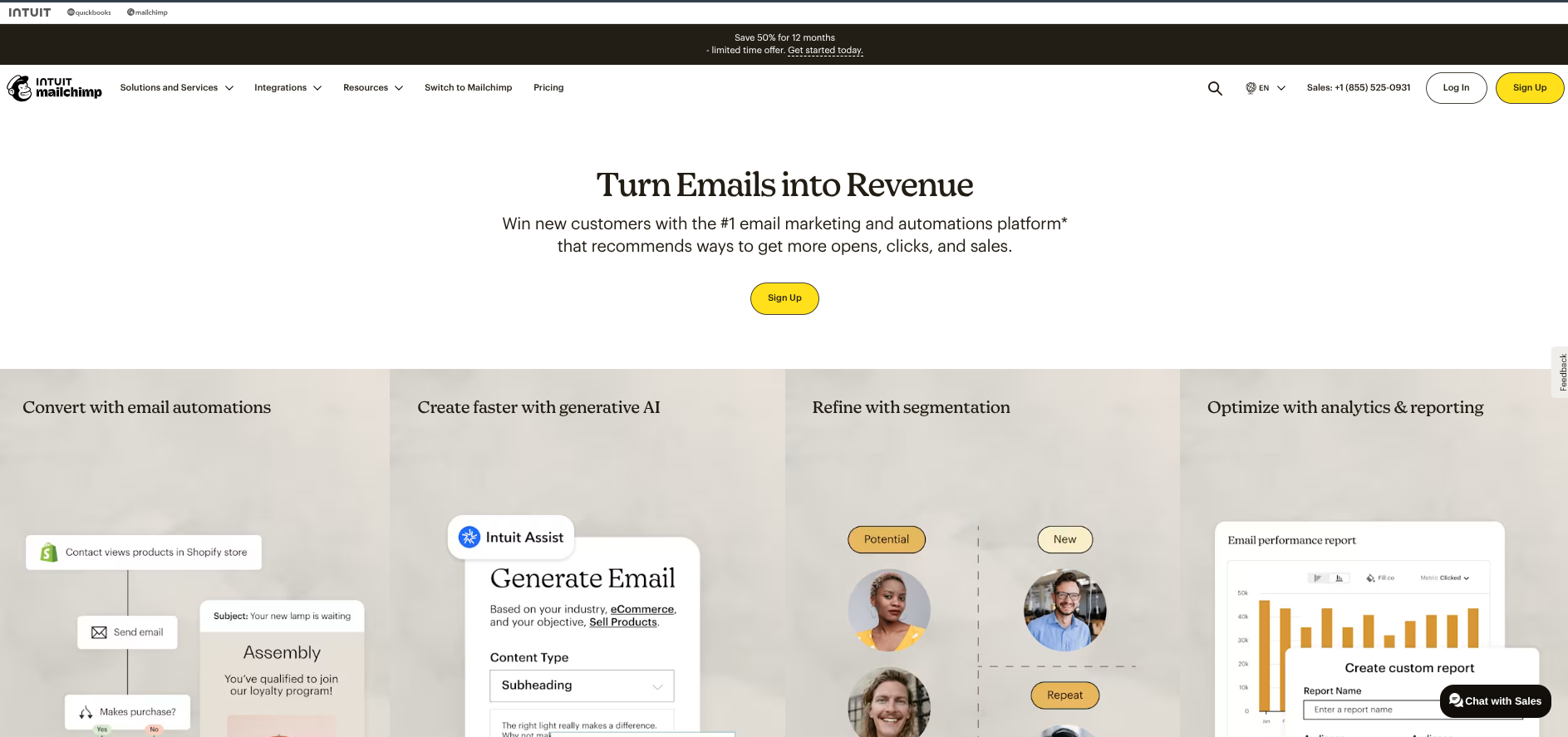
Mailchimp remains one of the most well-known names in email marketing and for good reason. It offers a complete suite of tools that go beyond newsletters, helping businesses manage email, automation, landing pages, CRM, and even eCommerce under one roof.
Originally known for its simplicity and iconic monkey branding, Mailchimp has since evolved into a comprehensive (though more complex) marketing platform tailored for small to medium-sized businesses that want an integrated marketing experience.
What Makes Mailchimp Unique?
Mailchimp is designed to be an all-in-one marketing platform offering much more than just newsletters.
Some standout features include:
- Drag-and-Drop Email Builder: Create professional campaigns with ease.
- A/B Testing: Optimize subject lines and content for better engagement.
- CRM & Customer Insights: Track customer journeys and behaviors.
- Built-in Landing Pages and Forms: Capture leads directly from your campaigns.
- Hundreds of Integrations: Connect with Shopify, WordPress, Squarespace, Zapier, and more.
It’s a solid choice for businesses that want everything from list management to analytics in one central platform.
Ease of Use and Design
Mailchimp’s email editor and dashboard are polished and user-friendly, especially for beginners. The drag-and-drop builder, modern templates, and AI-assisted copy generator make designing emails simple.
However, over time the platform has grown more complex. While that brings power and flexibility, it also introduces a learning curve especially for users who only need basic newsletter tools.
Pricing
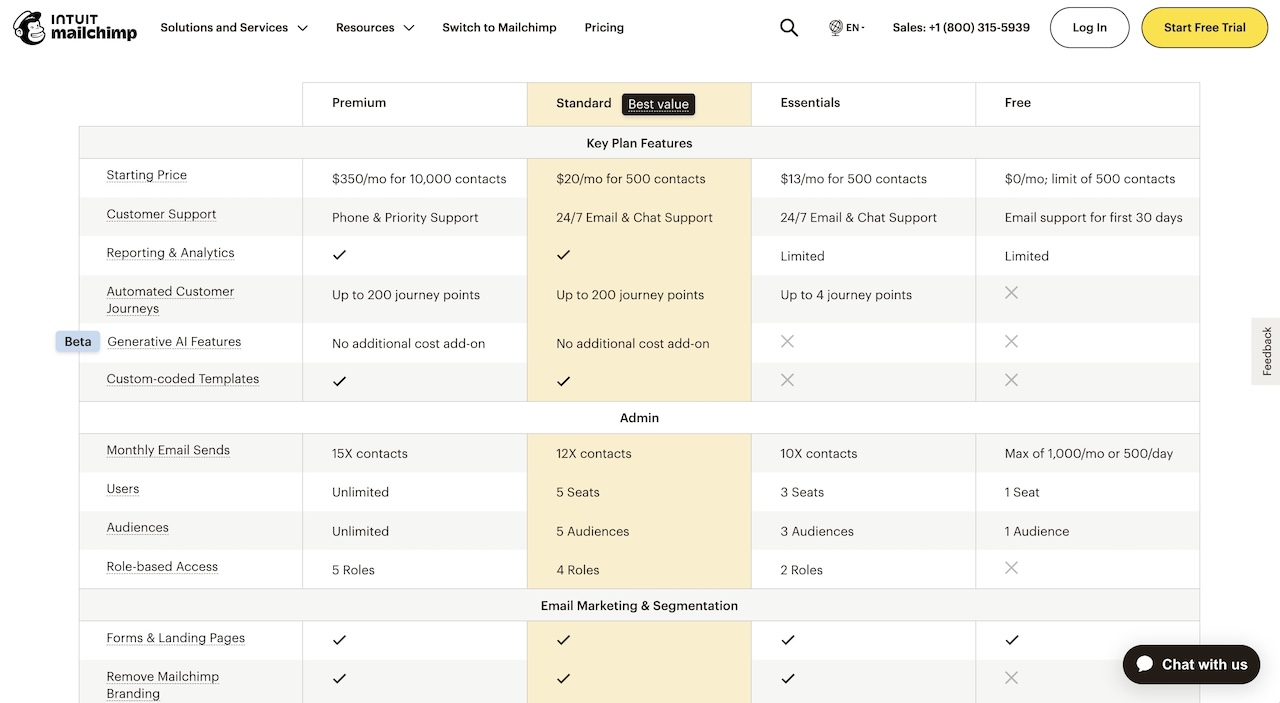
Mailchimp offers a limited free plan and several paid tiers. Pricing tends to rise quickly as your audience grows.
| Plan | Price | Subscribers | Notes |
|---|---|---|---|
| Free | $0/month | Up to 500 | Limited email marketing features, basic builder, limited tools |
| Essentials | $13/month | Starts at 500 | A/B testing, templates, automation |
| Standard | $20/month | Starts at 500 | Advanced segmentation, analytics, CRM |
| Premium | $350/month | Starts at 10,000 | Migration support, dedicated manager, advanced reporting |
Pros and Cons
Pros
- Clean, beginner-friendly interface
- Excellent drag-and-drop email editor
- Over 500 integrations with major platforms
- Built-in CRM and eCommerce tools
- Reliable reporting and analytics
Cons
- Pricing scales quickly with list size
- Automation and advanced tools locked behind higher plans
- Limited free tier (only 500 contacts)
- Migration support only on expensive Premium plans
Migration and Support
Mailchimp offers migration assistance for Premium plan users including help with importing contacts, rebuilding segments, and reconnecting integrations like Shopify or Zapier.
While helpful, this service comes at a high cost (starting around $309/month), which makes it less accessible for smaller teams.
Who Is Mailchimp For?
Mailchimp is ideal for small and medium-sized businesses, agencies, and marketers who want a centralized marketing hub with CRM, analytics, landing pages, and email campaigns in one place.
If you prioritize integrations, scalability, and brand familiarity, Mailchimp remains a strong option. However, if you’re focused purely on newsletters or creator monetization, platforms like Beehiiv or ConvertKit may offer better value.
4. Substack
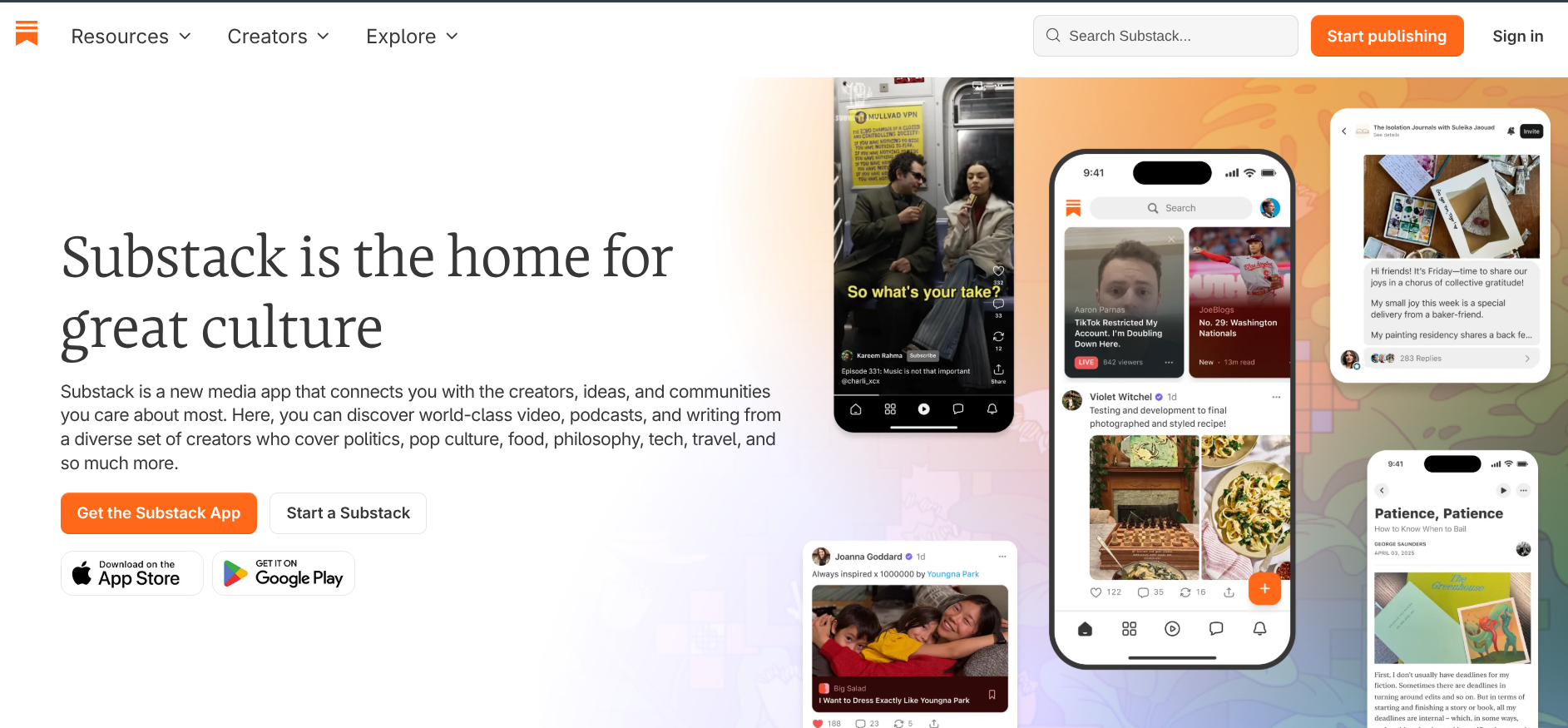 Best for independent writers monetizing through subscriptions.
Best for independent writers monetizing through subscriptions.
Substack is a writer-first newsletter platform designed for simplicity, content ownership, and built-in monetization. It combines writing, community, and subscription tools in one place ideal for independent publishers and creators who want to grow organically.
Key Features
- Subscription and payment tools built-in.
- Community-building through comments, chats, and recommendations.
- Podcast and video support for multimedia creators.
Pros and Cons:
Pros
- Easy setup and publishing process.
- Built-in monetization through paid subscriptions.
- Strong community features (Chats, Notes, Recommendations).
Cons
- Takes a 10% cut from paid subscriptions.
- Limited customization and automation.
- Few integrations with other platforms.
Pricing
Substack is free to use with unlimited subscribers. They take a 10% cut from paid subscriptions, plus a small billing fee.
Who Substack is for?
Substack remains a simple, engaging choice for independent writers who value community and creative control over complex marketing tools. However, its high transaction fees and limited customization may push professional creators toward alternatives like Beehiiv or Ghost for more flexibility and growth options.
5. Ghost
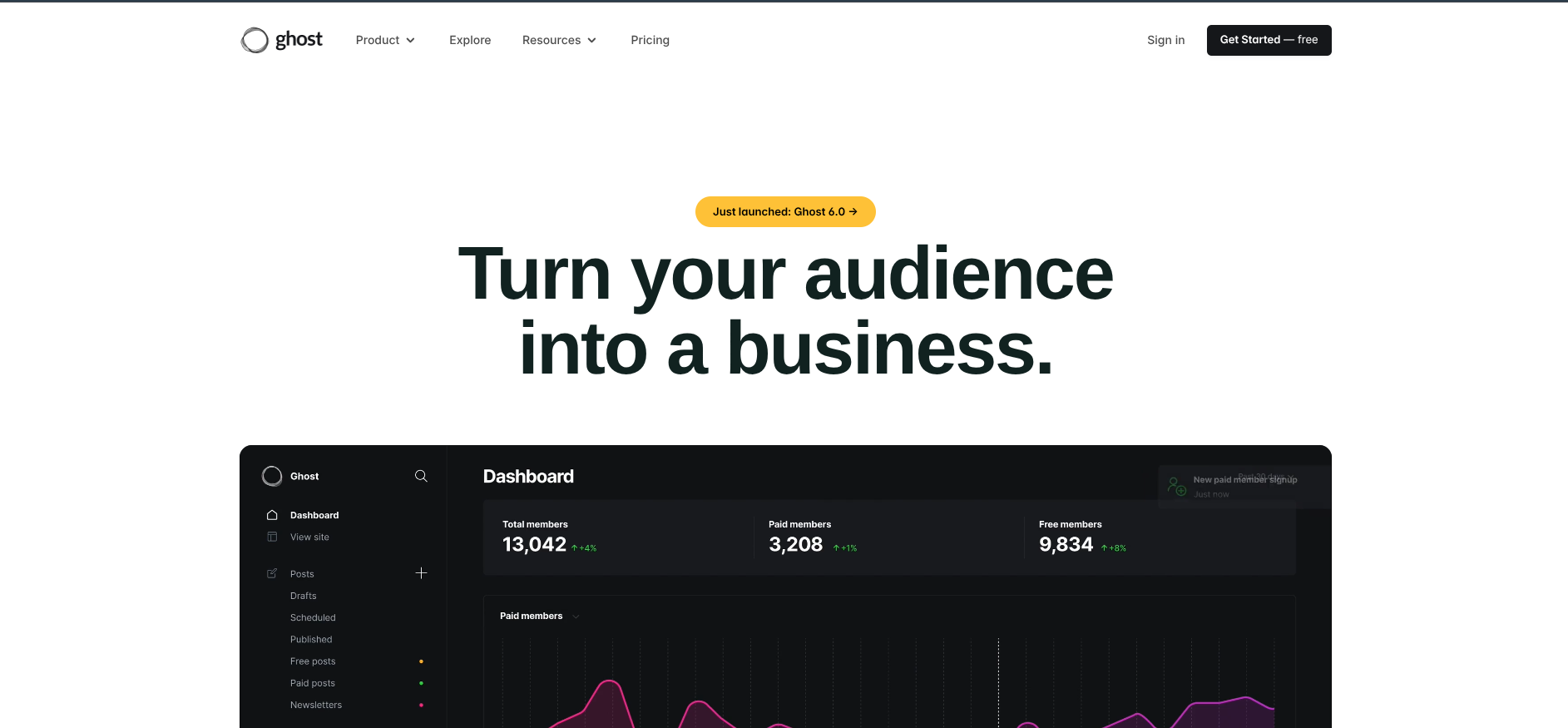
Best for content-first publishers integrating blogs and newsletters.
Ghost is an open-source platform combining blogging and newsletter capabilities. It’s ideal for publishers and creators who want a cohesive online presence, SEO-friendly content, and subscription-based monetization.
Support & Resources
- Ghost offers a rich ecosystem of support and resources, including:
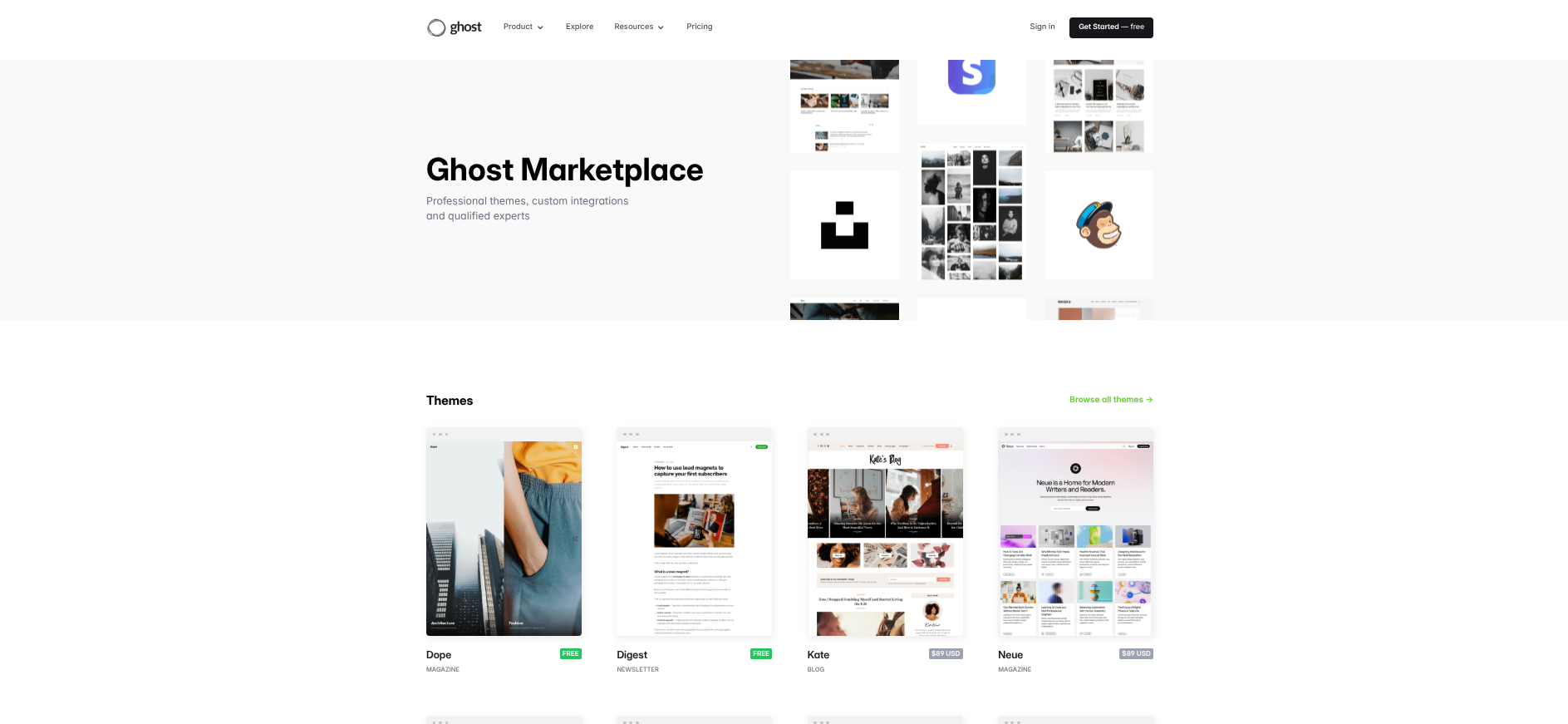
- Marketplace: Professional themes, custom integrations, and certified experts.
- Themes: Hundreds of beautifully designed publication templates.
- Integrations: Connect thousands of apps and services with your website.
- Experts: Certified Ghost developers to help build your site.
- Start Here: Guides, stories, interviews, and tips for success.
Analytics
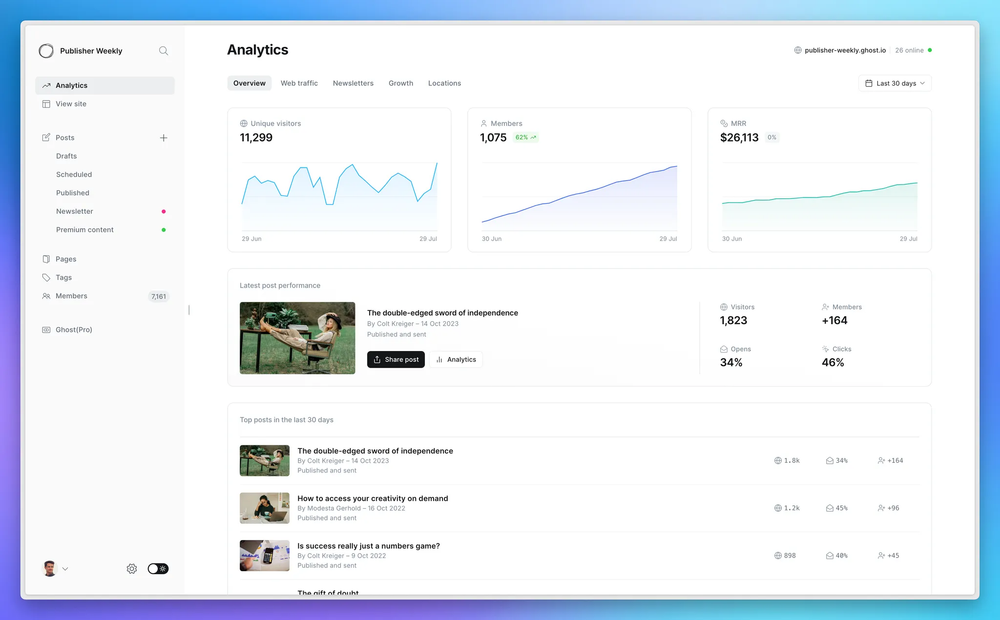
Ghost offers powerful, first-party analytics fully integrated into your site, providing a complete picture of audience engagement without relying on third-party tools. You can track web traffic, newsletter performance, member growth, and revenue, all in real time.
Metrics include unique visitors, total views, top-performing content, referral sources, and membership breakdowns (free vs. paid), along with Monthly Recurring Revenue (MRR) for paid subscriptions. Filters allow analysis by date range, audience segment, or specific newsletters, while global visitor locations and top content sources help optimize growth strategies all with a privacy-friendly, cookie-free approach.
Key Features
- All-in-one CMS for content publishing and newsletters.
- Memberships, paywalls, and subscription tiers.
- Native SEO tools for URLs, meta descriptions, and featured snippets.
- Markdown-based editor with Grammarly integration for a streamlined workflow.
- Automatic email delivery of posts to subscribers.
Pros and Cons:
Pros
- Integrated blog and newsletter publishing.
- Open-source flexibility for customization.
- Built-in membership and monetization features.
- SEO-optimized for better discoverability.
Cons
- Requires technical knowledge for setup, especially self-hosted.
- Limited third-party integrations compared to competitors.
- Higher costs as audience size grows.
Pricing
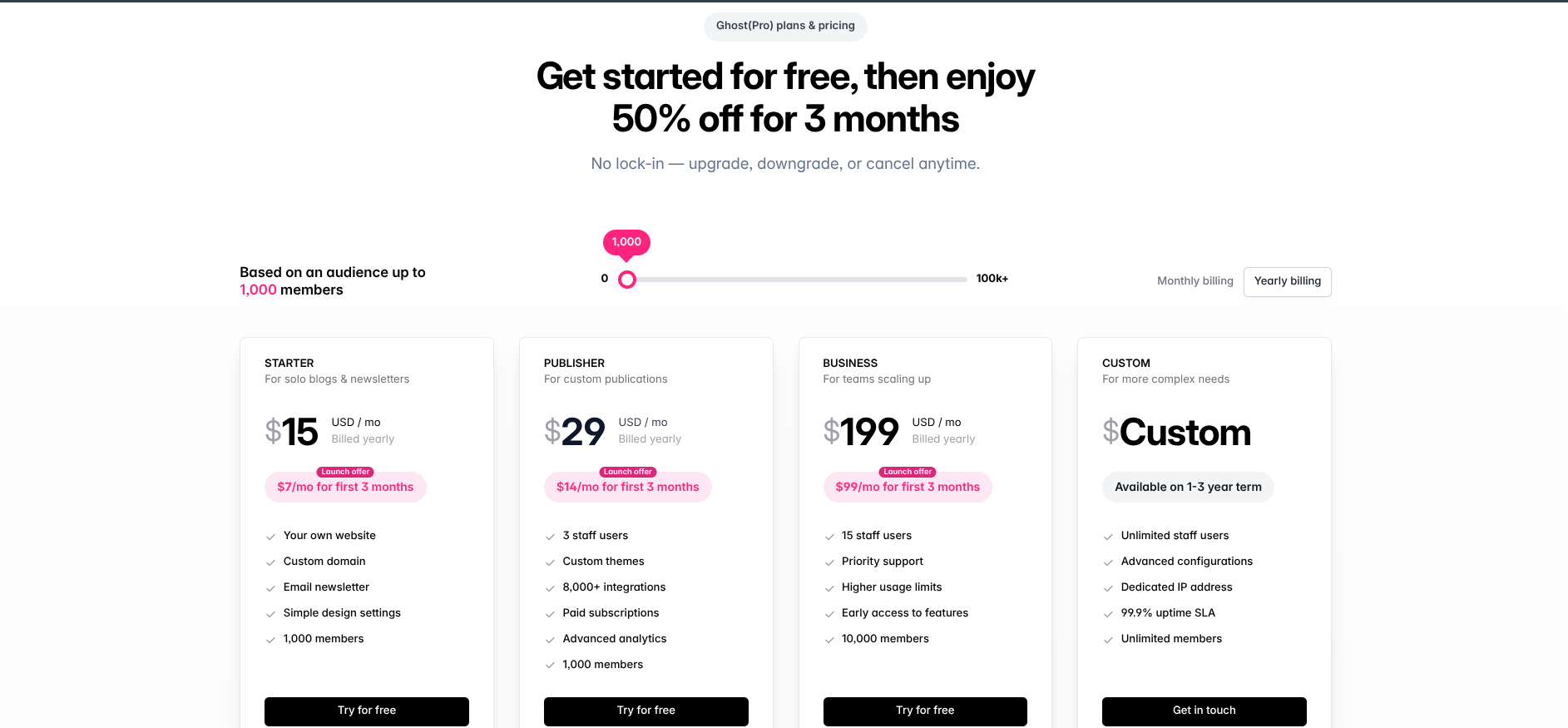
| Plan | Base Price (Per Month) | Limited Offer | Key Features |
|---|---|---|---|
| STARTER | $15 USD | $7/mo for 3 months | Your own website, Custom domain, Email newsletter, 1,000 members |
| PUBLISHER | $29 USD | $14/mo for 3 months | 3 staff users, Custom themes, 8,000+ integrations, Paid subscriptions, 1,000 members |
| BUSINESS | $199 USD | $99/mo for 3 months | 15 staff users, Priority support, Higher usage limits, 10,000 members |
| CUSTOM | Custom | Available on 1-3 year term | Unlimited staff users, Dedicated IP address, 99.9% uptime SLA, Unlimited members |
Who Ghost is for?
Ghost is perfect for publishers, content-heavy creators, and teams who want full ownership of content and subscribers, seamless integration of blogs and newsletters, and strong SEO out of the box.
However, it may be less suitable for beginners or small teams without technical support, and costs can rise quickly with larger audiences. Ghost is a powerful choice for creators prioritizing content-first publishing and flexibility, especially when paired with Ghost Pro for hassle-free hosting and email delivery.
6. Mailerlite
Best for affordability and user-friendly features.
MailerLite is a popular email marketing platform known for its simplicity, affordability, and intuitive interface. It is particularly well-suited for small businesses, creators, and newsletter writers who want an all-in-one solution to grow and monetize their audience without the complexity of high-end enterprise tools.
Key Features
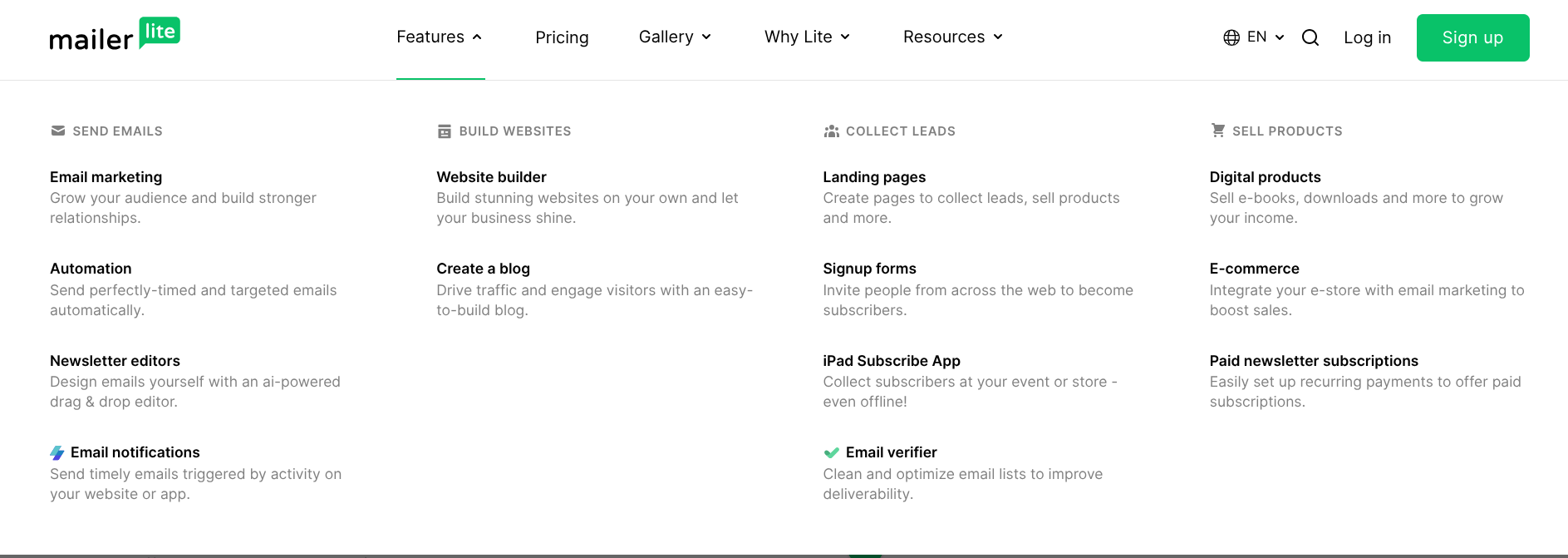
- Email Marketing: Grow your audience and strengthen relationships.
- Automation: Send targeted emails automatically.
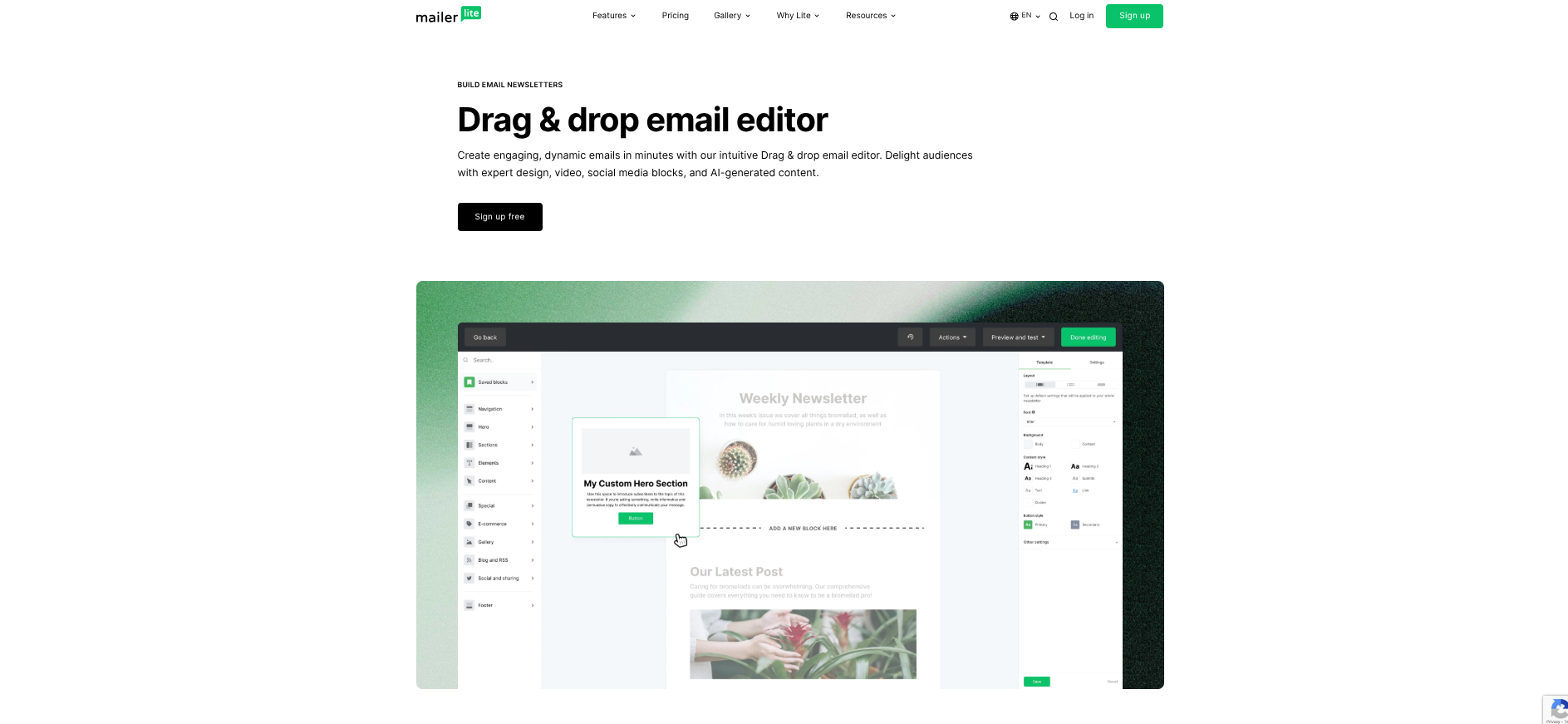
- Newsletter Editors: AI-powered drag & drop editor for designing emails.
- Email Notifications: Trigger timely emails based on user activity.
- Website Builder: Create and host professional websites.
- Create a Blog: Easy-to-build blog to drive traffic and engagement.
- Landing Pages: Capture leads and promote products.
- Signup Forms & iPad Subscribe App: Collect subscribers online and offline.
- Paid Newsletter Subscriptions: Set up recurring payments for subscribers.
Pros and Cons
Pros
- Competitive pricing with a generous free plan.
- User-friendly drag-and-drop editor and landing page builder.
- Automation tools for engagement and paid content delivery.
- All-in-one platform: newsletter, landing pages, website, and paid subscriptions.
Cons
- Limited advanced features and integrations.
- No community-building tools.
- Basic templates and reporting on the free plan.
Pricing
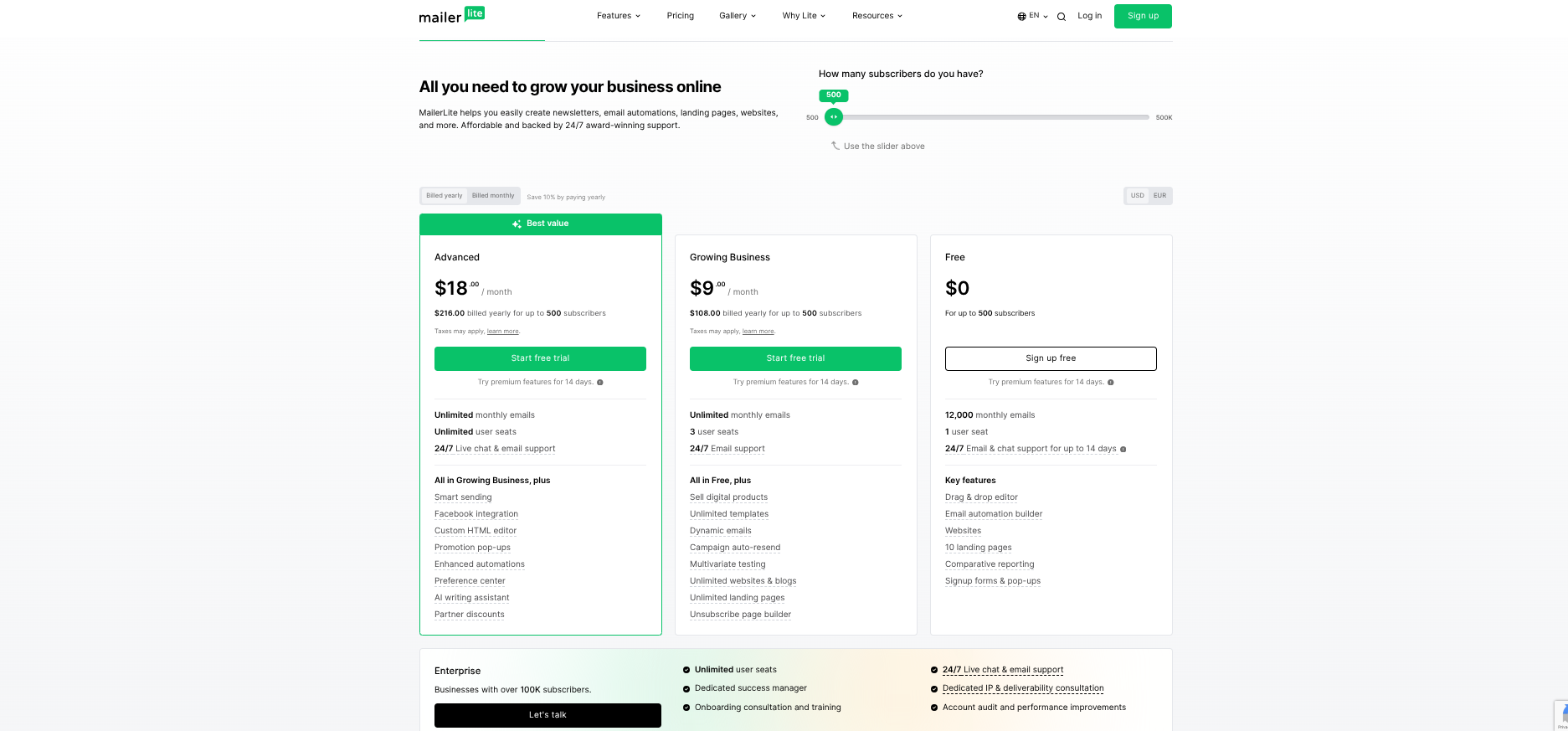
| Plan | Price (Per Month) | Core Limits & Support | Key Features |
|---|---|---|---|
| Free | $0 | Up to 500 subscribers, 12,000 monthly emails, 1 user seat, Email support (for 14 days) | Drag & drop editor, Email automation builder, Websites, 10 landing pages, Signup forms & pop-ups |
| Growing Business | $9 USD ($108 billed annually) | Up to 500 subscribers, Unlimited monthly emails, 3 user seats, 24/7 Email support | All in Free, plus: Sell digital products, Unlimited templates, Unlimited websites & blogs, Unlimited landing pages |
| Advanced | $18.40 USD ($216 billed annually) | Up to 500 subscribers, Unlimited monthly emails, Unlimited user seats, 24/7 Live chat & email support | All in Growing Business, plus: Custom HTML editor, Enhanced automations, Promotion pop-ups, AI writing assistant |
| Enterprise | Custom | For 100K+ subscribers, Unlimited user seats, 24/7 Live chat & email support | Dedicated success manager, Onboarding consultation, Dedicated IP & deliverability consultation, Account audit and improvements |
Who is MailerLite for?
MailerLite is perfect for creators, small businesses, and newsletter writers looking for a simple, affordable platform to grow and monetize their audience. It is ideal for those who want:
- An easy-to-use tool without a steep learning curve.
- Built-in support for paid subscriptions and digital products.
- A combined solution for newsletters, landing pages, and websites.
It is less suitable for organizations seeking advanced analytics, in-depth integration options, or community-building features.
7. Flodesk
Best for design-focused brands and creators who want stunning email campaigns with ease.
Flodesk is a modern email marketing platform built for brands that care deeply about design and simplicity. Its core philosophy “Today’s top brands have the best design. Now, so do you.” perfectly captures what it offers: beautifully designed emails made effortless.
Unlike many traditional tools, Flodesk focuses on visual storytelling, making it ideal for entrepreneurs, creators, and small businesses that want emails that look as good as their brand.
Key Features
- Design-first email builder: Drag-and-drop editor with stunning templates optimized for all devices.
- Shopify & WooCommerce integration: Seamlessly connect your store for easy automation and customer engagement.
- Audience segmentation: Send the right message to the right people with intuitive segmentation tools.
- Workflow automation: Build automated email sequences to nurture leads and boost conversions.
- Analytics dashboard: Track engagement, growth, and campaign performance effortlessly.
- Zapier integration: Extend functionality with hundreds of compatible tools and plugins.
Ease of Use
Flodesk is known for being one of the easiest platforms to use. Whether you’re an ecommerce veteran or just starting out, its clean interface and guided workflows make creating professional emails fast and enjoyable.
Pros and Cons
Pros
- Unlimited subscribers and emails (flat-rate pricing)
- Stunning design with some templates aimed for bloggers and creators
- Powerful form builder
- Simple digital sales via the Flodesk Checkout plan.
Cons
- Lack of paid subscription options
- Limited monetization, with no options beyond selling digital products
- No community-building features
- Basic automation
- No newsletter archive
Pricing
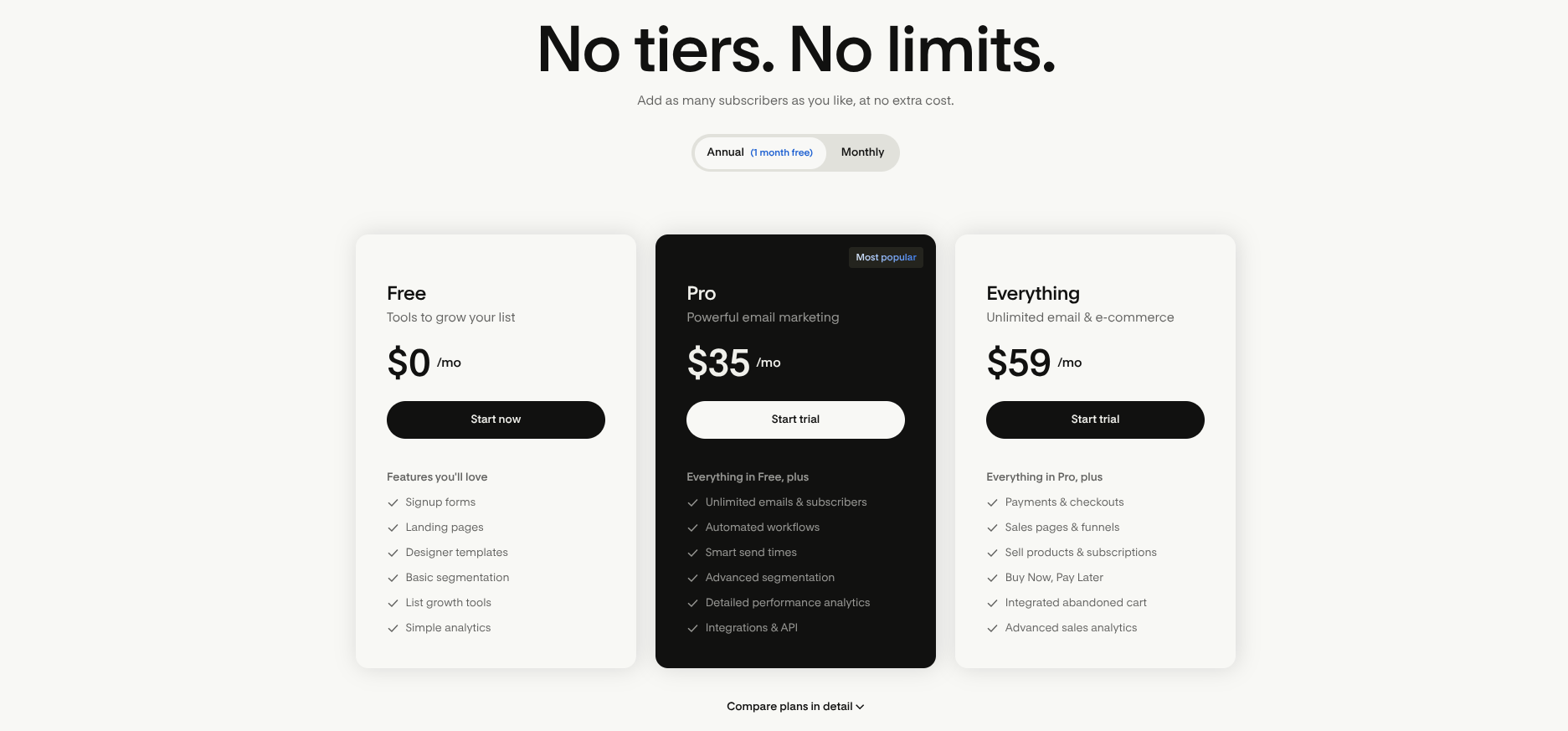
The prices shown are for the annual billing cycle.
| Plan | Price (Monthly) | Key Features |
|---|---|---|
| Free (Tools to grow your list) | $0 /mo | Signup forms, Landing pages, Designer templates, Basic segmentation, List growth tools, Simple analytics |
| Pro (Powerful email marketing) | $35 /mo | Everything in Free, plus: Unlimited emails & subscribers, Automated workflows, Advanced segmentation, Detailed performance analytics, Integrations & API |
| Everything (Unlimited email & e-commerce) | $59 /mo | Everything in Pro, plus: Payments & checkouts, Sales pages & funnels, Sell products & subscriptions, Integrated abandoned cart, Advanced sales analytics |
For the design quality and unlimited email sends, Flodesk’s pricing is among the most competitive in the market.
Who Flodesk is for?
Flodesk is perfect for:
- Creators and small businesses focused on branding and aesthetics.
- Ecommerce stores looking for Shopify/WooCommerce integration.
- Founders who want beautiful emails without technical complexity.
8. EmailOctopus
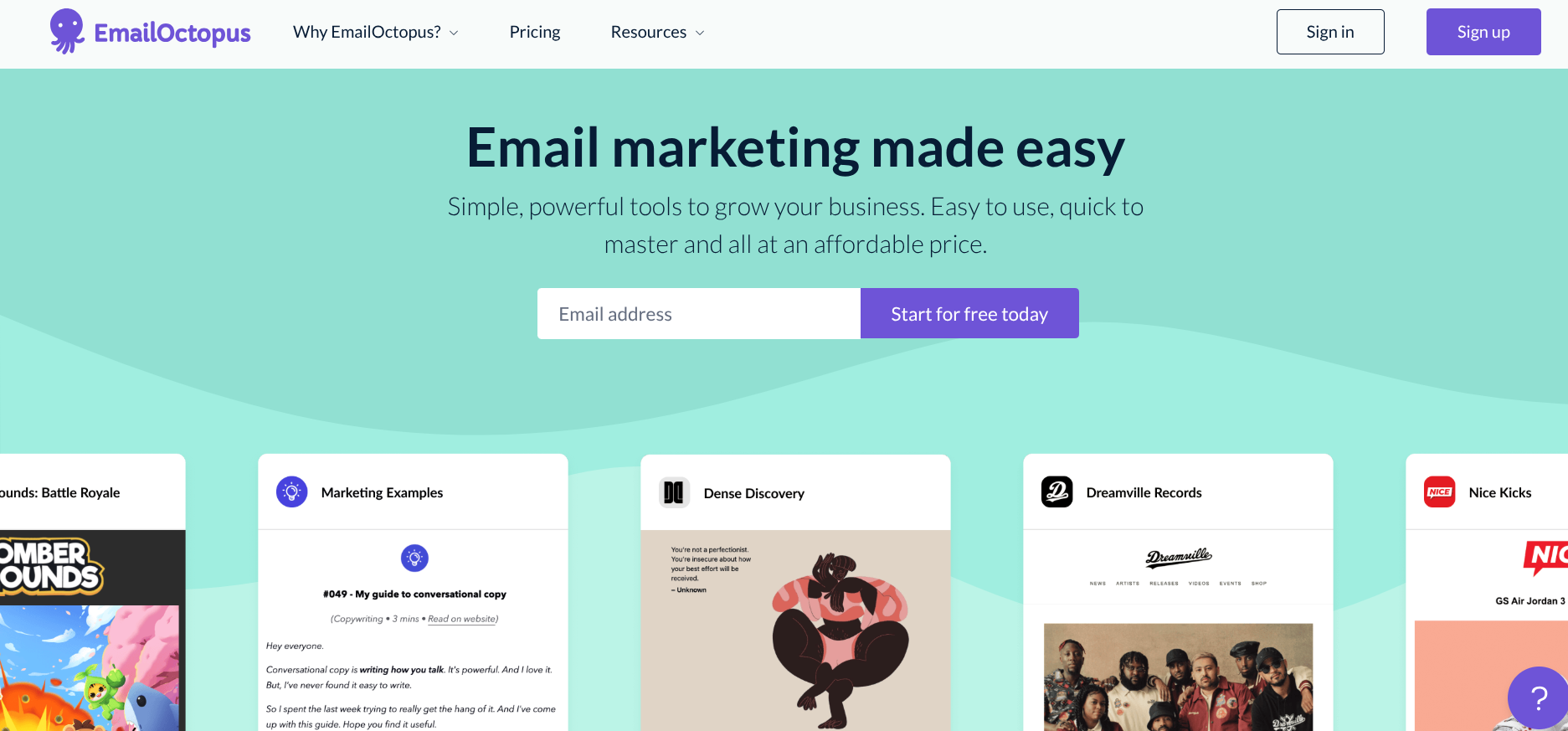 Best for small businesses and creators looking for an affordable, simple email marketing solution.
Best for small businesses and creators looking for an affordable, simple email marketing solution.
EmailOctopus is a powerful yet straightforward email marketing platform built for creators, startups, and small businesses that want to send professional newsletters without the complexity or cost of enterprise tools. With its clean interface, customizable templates, and automation features, it allows you to create, schedule, and optimize campaigns with ease.
Key Features
- Drag-and-drop email builder for professional-looking campaigns.
- Automated workflows for welcome sequences, drip campaigns, and re-engagement.
- Detailed analytics to track open rates, clicks, and performance.
- Integrations with Zapier, WordPress, and other popular tools.
- Subscriber segmentation for personalized and targeted emails.
Pros and Cons
Pros
- Extremely affordable pricing with generous email-sending limits.
- Simple and beginner-friendly interface.
- Seamless integrations with popular tools and APIs.
Cons
- Limited ecommerce functionality compared to enterprise platforms.
- No built-in SMS or advanced marketing automation.
Pricing
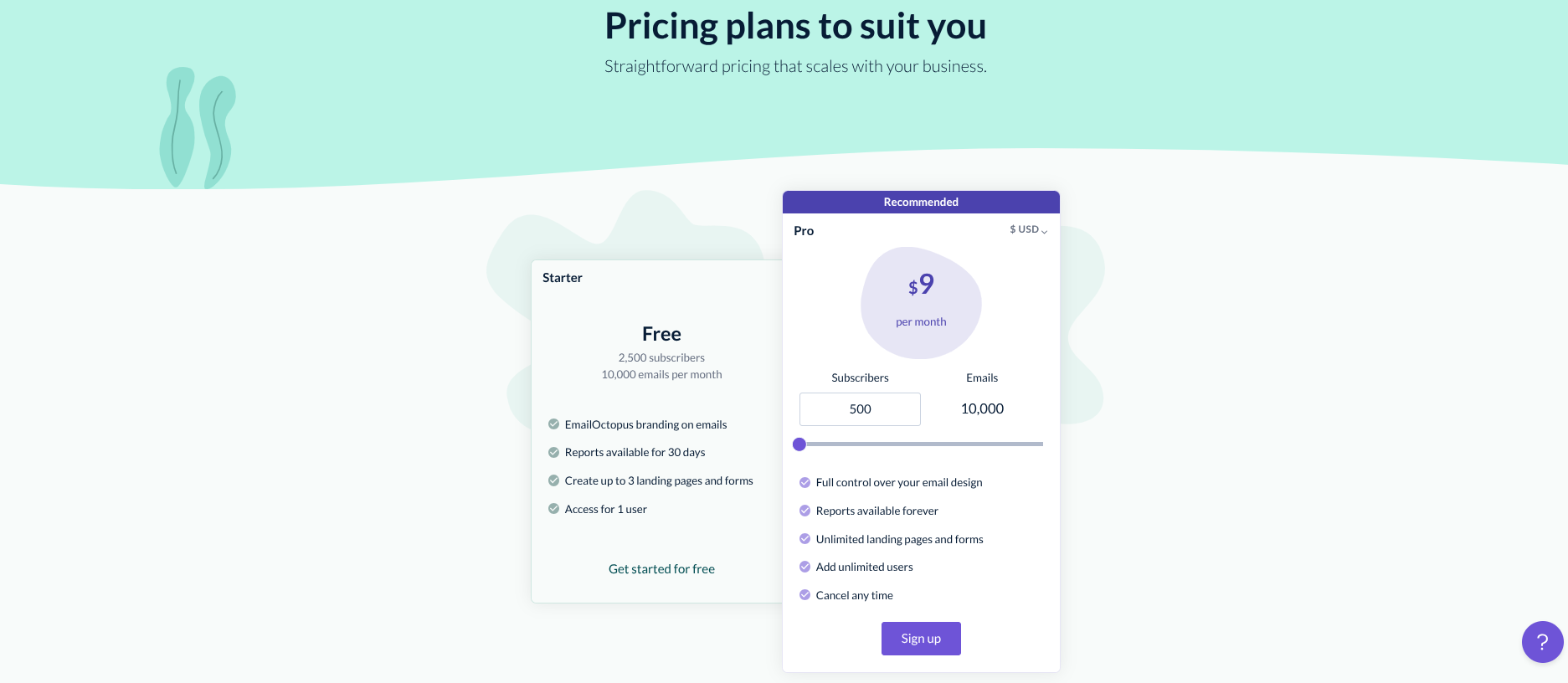
| Plan | Price | Key Features & Limits |
|---|---|---|
| Starter | Free | 2,500 subscribers, 10,000 emails per month, EmailOctopus branding on emails, Reports available for 30 days, Up to 3 landing pages and forms, Access for 1 user |
| Pro | $9 per month | Based on 500 subscribers, Full control over email design, Reports available forever, Unlimited landing pages and forms, Add unlimited users, Cancel any time |
Who EmailOctopus is for?
- Small businesses seeking a budget-friendly email marketing solution.
- Startups and independent creators who want simple automation and reporting.
- Teams looking to integrate email marketing with tools like Zapier and WordPress.
9. Liveintent
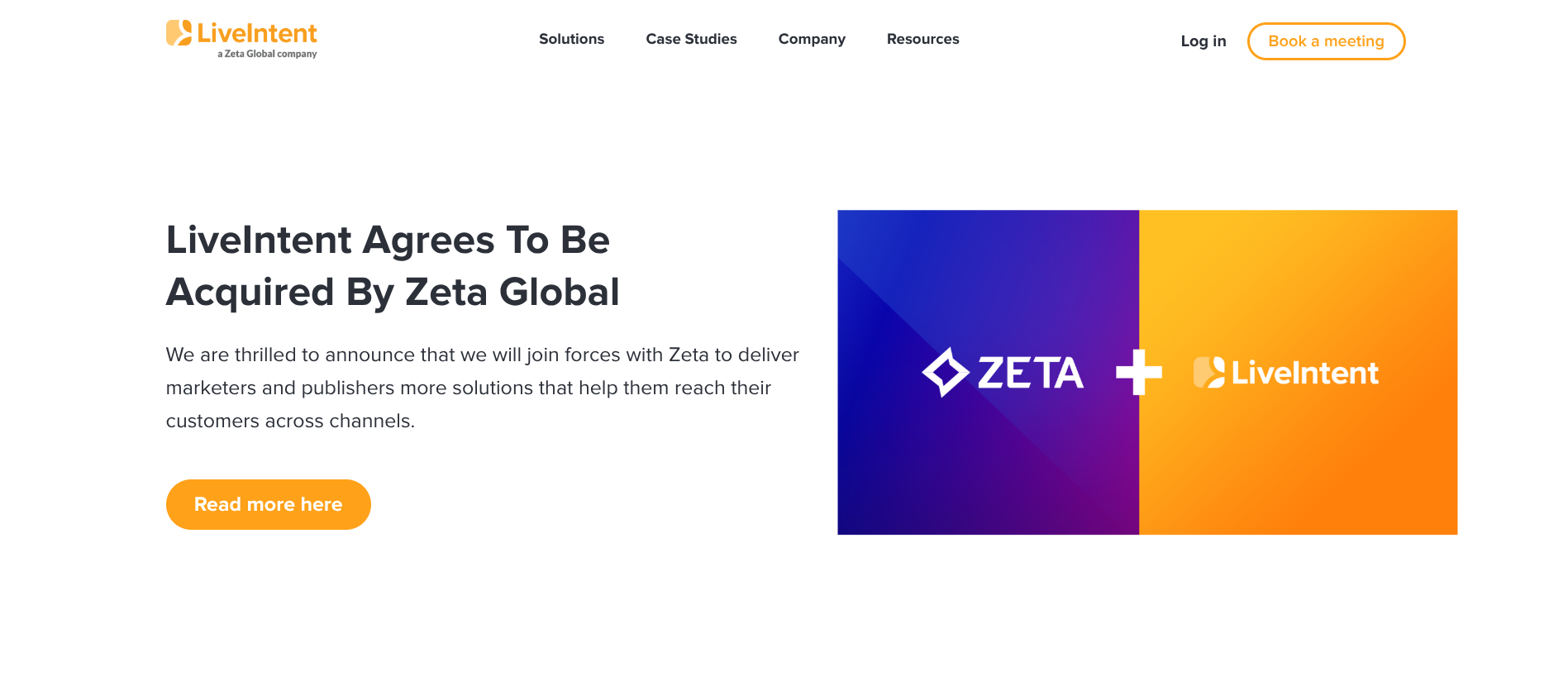 Best for publishers and media brands monetizing through ads.
Best for publishers and media brands monetizing through ads.
LiveIntent is an email marketing and advertising platform built specifically for publishers and content-driven businesses that rely on ad revenue. Its primary focus is integrating ads seamlessly into newsletters, helping publishers unlock new monetization opportunities directly within their email content.
Alongside ad placement, LiveIntent provides advanced audience segmentation and analytics tools to help businesses understand engagement and maximize revenue performance.
Key Features
- Integrated ad solutions for monetizing newsletters.
- Audience segmentation for personalized ad delivery.
- Real-time analytics to track engagement and ad effectiveness.
- Tools to manage and optimize multiple campaigns.
- Support for cross-channel audience targeting.
Pros and Cons
Pros
- Excellent ad monetization tools built specifically for publishers.
- Strong analytics and audience insights.
- Seamless integration with most major ESPs (Email Service Providers).
Cons
- Pricing details not publicly available (requires direct inquiry).
- Complex setup process for first-time users.
Pricing
LiveIntent does not provide transparent pricing publicly. Costs typically depend on ad inventory, email volume, and audience size. Interested publishers can contact LiveIntent directly for a custom quote.
10. Campaign Monitor
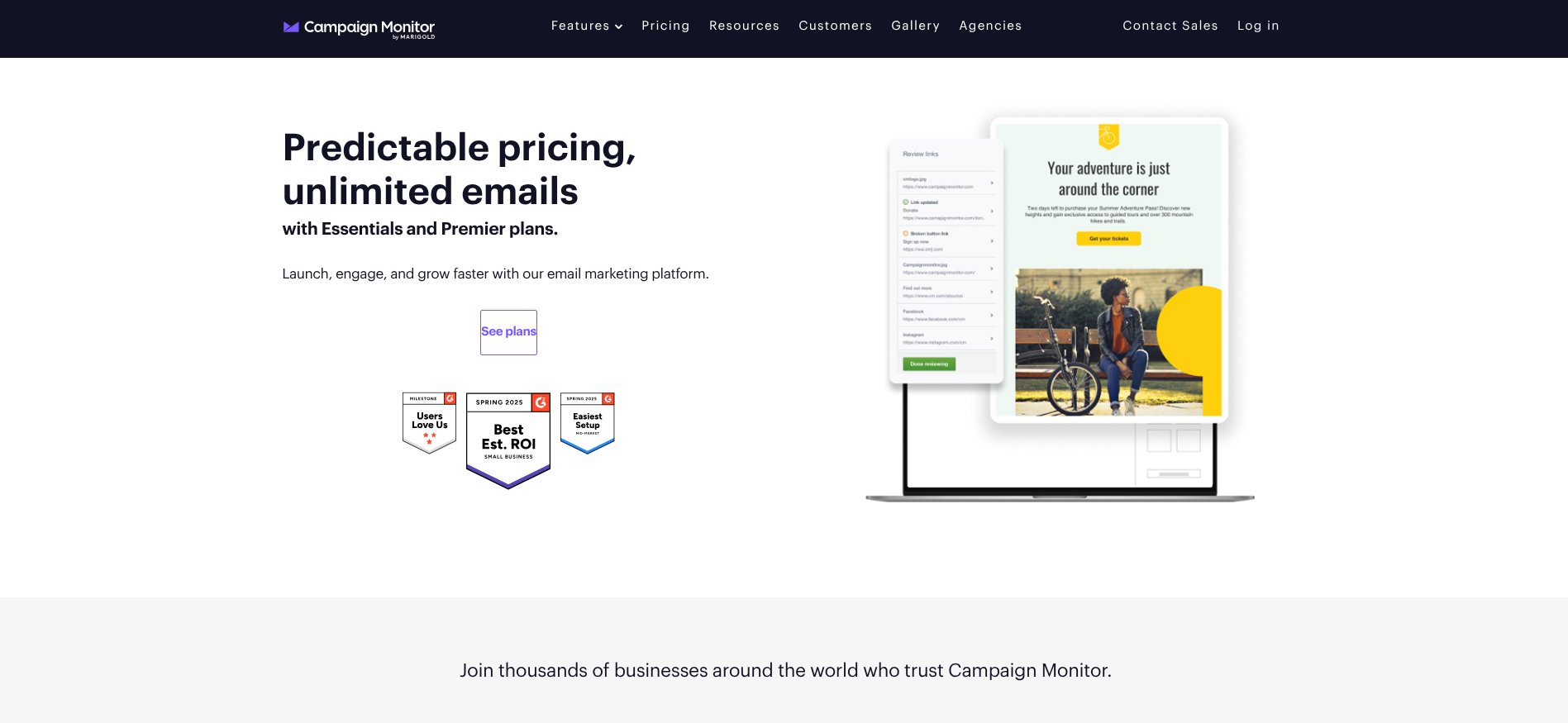 Best for advanced reporting and analytics.
Best for advanced reporting and analytics.
Campaign Monitor is a feature-rich email marketing platform designed for small businesses that already have products or services and want to expand their reach through newsletters. It combines ease of use with powerful analytics, helping users create, automate, and optimize their email campaigns for better engagement and conversion.
Key Features
- Drag-and-drop email builder with professional templates.
- Advanced segmentation for targeted email campaigns.
- Automation workflows for personalized customer journeys.
- Comprehensive analytics and reporting dashboards.
- SMS marketing and ecommerce integration options.
Pros and Cons
Pros
- Robust analytics and detailed reporting capabilities.
- Customizable templates for consistent brand identity.
- Simple and intuitive interface for campaign creation.
Cons
- Higher pricing tiers for advanced features.
- Limited automation depth compared to specialized tools.
Pricing
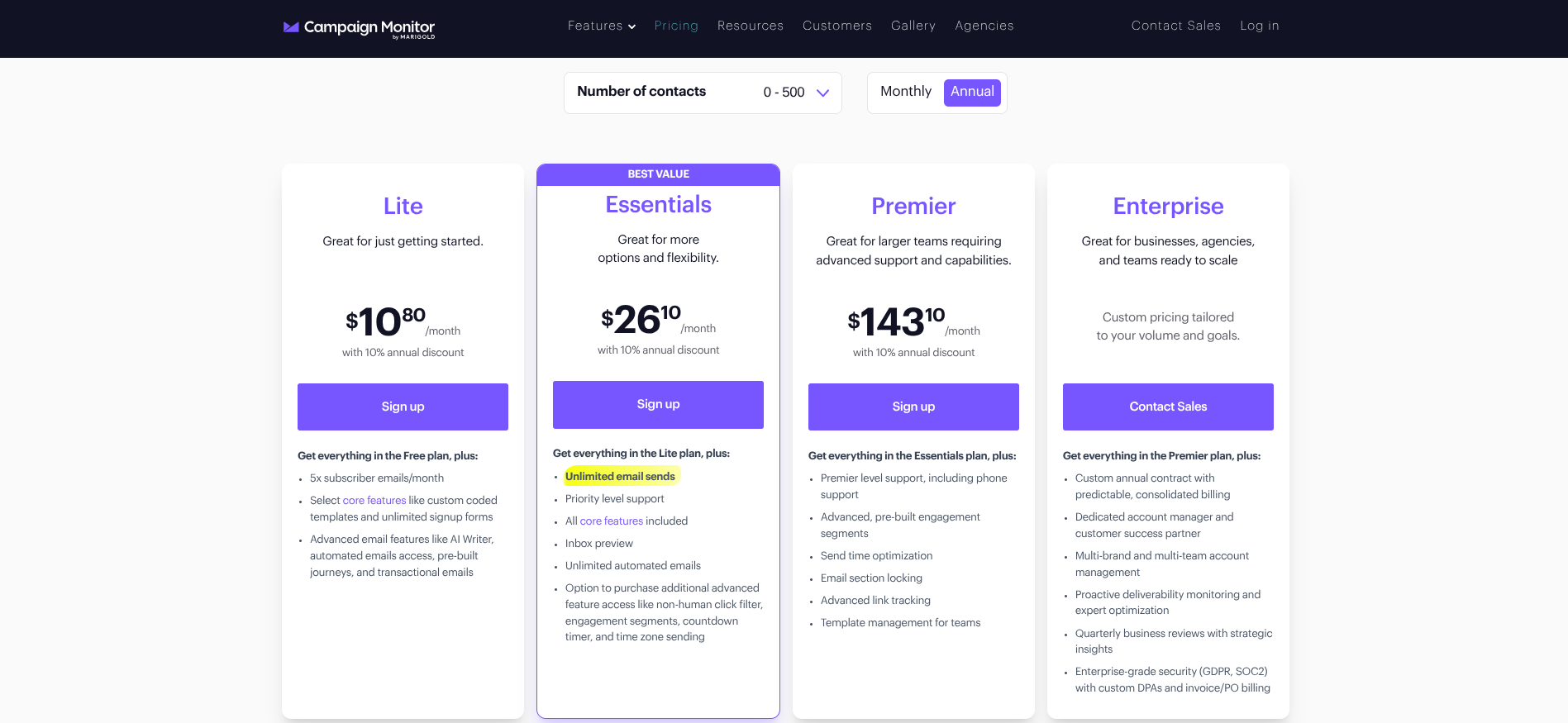
| Plan | Price (Per Month) | Best For | Key Features |
|---|---|---|---|
| Lite | $10.80 | Great for just getting started. | Get everything in the Free plan, plus: 5,000 emails/month, Custom coded templates, Unlimited signup forms, AI Writer & automated emails |
| Essentials | $26.10 | Great for more options and flexibility. | Get everything in the Lite plan, plus: Unlimited email sends, Priority level support, All core features included, Inbox preview, Unlimited automated emails |
| Premier | $143.10 | Great for larger teams requiring advanced support and capabilities. | Get everything in the Essentials plan, plus: Premier level support, including phone support, Advanced, pre-built engagement segments, Send time optimization, Template management for teams |
| Enterprise | Custom | Great for businesses, agencies, and teams ready to scale. | Get everything in the Premier plan, plus: Custom annual contract, Dedicated account manager, Multi-brand account management, Proactive deliverability monitoring |
Who Campaign Monitor is for?
- Small to mid-sized businesses focused on performance analytics.
- Brands seeking in-depth reporting and audience insights.
- Companies combining ecommerce, SMS, and email marketing.
Final Thoughts
Choosing the right paid newsletter platform ultimately comes down to your goals, budget, and audience. Whether you’re an independent creator seeking to monetize your content or a growing business aiming to strengthen customer relationships, platforms like beehiiv, Ghost, and MailerLite stand out as the best options in 2025.
Each offers a balance of usability, performance, and scalability, making it easier than ever to build, grow, and sustain a successful newsletter. Take the time to assess your priorities, explore these tools, and pick the one that aligns best with your long-term vision.